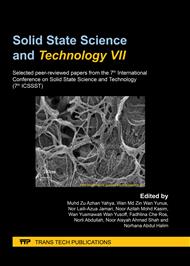[1]
A. Blanco, M.C. Monte, C. Campano, A. Balea, N. Merayo, C. Negro, Nanocellulose for Industrial Use: Cellulose Nanofibers (CNF), Cellulose Nanocrystals (CNC) and Bacterial Cellulose (BC), in: C.M. Hussain (Eds.), Handbook of Nanomaterials for Industrial Applications, Elsevier, 2018, pp.74-126.
DOI: 10.1016/b978-0-12-813351-4.00005-5
Google Scholar
[2]
M.N.F. Norrrahim, H. Ariffin, T.A.T. Yasim-Anuar, F. Ghaemi, M.A. Hassan, N.A. Ibrahim, J.L.H. Ngee, W.M.Z.W. Yunus, Superheated steam pretreatment of cellulose affects its electrospinnability for microfibrillated cellulose production, Cellulose 25(7) (2018) 3853–3859.
DOI: 10.1007/s10570-018-1859-3
Google Scholar
[3]
D. Sun, B. Ma, C. Zhu, C.-S. Liu, J.-Z. Yang, Novel Nitrocellulose Made from Bacterial Cellulose, Journal of Energetic Materials 28(2) (2010) 85–97.
DOI: 10.1080/07370650903222551
Google Scholar
[4]
M.M. Mahmud, A. Perveen, R.A. Jahan, M.A. Matin, S.Y. Wong, X. Li, M.T. Arafat, Preparation of different polymorphs of cellulose from different acid hydrolysis medium, International Journal of Biological Macromolecules 130 (2019) 969–976.
DOI: 10.1016/j.ijbiomac.2019.03.027
Google Scholar
[5]
H. Grau, A.Y. Fadeev, Raincoat for explosives,: Surface chemistry approach to control wetting of nitrocellulose with nitroglycerin, Journal of Colloid and Interface Science 547 (2019) 145–152.
DOI: 10.1016/j.jcis.2019.03.063
Google Scholar
[6]
K. Jedvert, T. Heinze, Cellulose modification and shaping – a review, Journal of Polymer Engineering 37(9) (2017) 1-16.
Google Scholar
[7]
Y.A. Gismatulina, V.V. Budaeva, G.V. Sakovich, Nitrocellulose Synthesis from Miscanthus Cellulose, Propellant, Explosives, Pyrotechnics 42 (2017) 1–6.
DOI: 10.1002/prep.201700210
Google Scholar
[8]
M.A Fernandez de la Ossa, M. Torre, C. Garcia-Ruiz, Nitrocellulose in propellants: characteristics and thermal properties in: M.C. Wythers (Eds.), Advances in Materials Science Research, Nova Science Publishers Inc., 2012, pp.201-220.
Google Scholar
[9]
C. Selwitz, Cellulose Nitrate in Conservation, The getty conversation institute (1988).
Google Scholar
[10]
C.W. Saunders, L.T. Taylor, A review of the synthesis, chemistry and analysis of nitrocellulose, Journal of Energetic Materials 8(3) (1990) 149-203.
Google Scholar
[11]
M. Moniruzzaman, J.M. Bellerby, N. Mai, The effect of light on the viscosity and molecular mass of nitrocellulose, Polymer Degradation and Stability 96(5) (2011) 929–935.
DOI: 10.1016/j.polymdegradstab.2011.01.026
Google Scholar
[12]
H. Kono, S. Yunoki, T. Shikano, M. Fujiwara, T. Erata, and M. Takai, CP/MAS 13C NMR Study of Cellulose and Cellulose Derivatives . 1 . Complete Assignment of the CP/MAS 13 C NMR Spectrum of the Native Cellulose, Journal American Chemical Society 124 (2002) 7506–7511.
DOI: 10.1021/ja010704o
Google Scholar
[13]
S.H. Jamal, N. J. Roslan, N.A.A. Shah, S.A.M. Noor, K.K. Ong, W.M.Z.W. Yunus, Preparation and characterization of nitrocellulose from bacterial cellulose for propellant uses, Material Today: Proceedings (In press) (2020).
DOI: 10.1016/j.matpr.2020.05.540
Google Scholar
[14]
S. Ma, G. Song, N. Feng, Preparation and characterization of self-emulsified waterborne nitrocellulose, Carbohydrate Polymers 89(1) (2012) 36–40.
DOI: 10.1016/j.carbpol.2012.02.029
Google Scholar
[15]
M.N. Costa, B. Veigas, J.M. Jacob, D.S. Santos, J. Gomes, P.V. Baptista, R. Martins, J. Inácio, E. Fortunato, A low cost, safe, disposable, rapid and self-sustainable paper-based platform for diagnostic testing: lab-on-paper, Nanotechnology. 25 (2014) 094006.
DOI: 10.1088/0957-4484/25/9/094006
Google Scholar
[16]
D. Trache, K. Khimeche, A. Mezroua, M. Benziane, Physicochemical properties of microcrystalline nitrocellulose from Alfa grass fibres and its thermal stability, Journal of Thermal Analysis and Calorimetry 124 (2016) 1485-1496.
DOI: 10.1007/s10973-016-5293-1
Google Scholar


